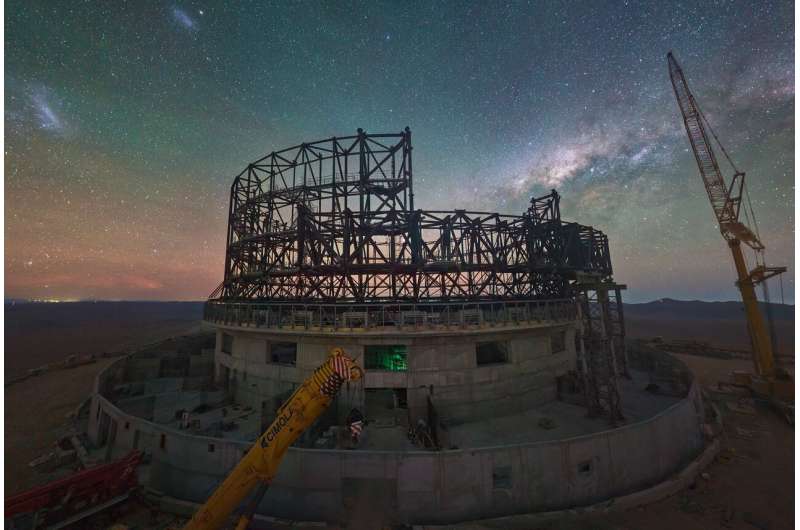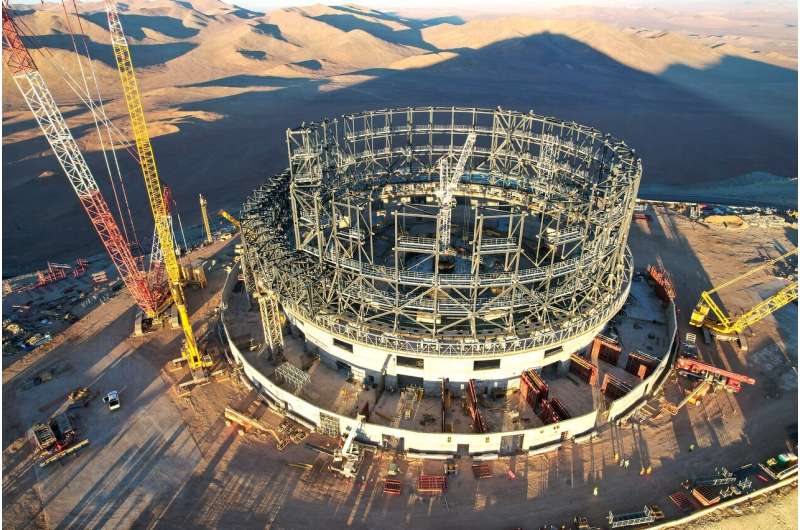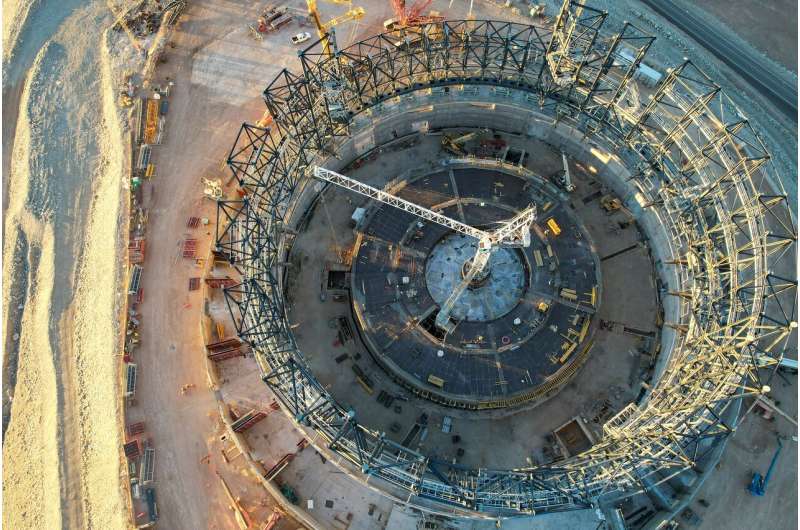This article has been reviewed according to Science X's editorial process and policies. Editors have highlighted the following attributes while ensuring the content's credibility:
fact-checked
trusted source
proofread
ESO's Extremely Large Telescope is now half completed

The European Southern Observatory's Extremely Large Telescope (ESO's ELT) is a revolutionary ground-based telescope that will have a 39-meter main mirror and will be the largest telescope in the world for visible and infrared light: the world's biggest eye on the sky. Construction of this technically complex project is advancing at a good pace, with the ELT now surpassing the 50% complete milestone.
The telescope is located atop Cerro Armazones in Chile's Atacama Desert, where engineers and construction workers are currently assembling the structure of the telescope dome at a staggering pace. Visibly changing each day, the steel structure will soon acquire the familiar round shape typical of telescope domes.
The telescope mirrors and other components are being built by companies in Europe, where work is also progressing well. ESO's ELT will have a pioneering five-mirror optical design, which includes a giant main mirror (M1) made up of 798 hexagonal segments.
More than 70% of the blanks and supports for these segments have now been manufactured, while M2 and M3 are cast and in the process of being polished. Progress on M4, an adaptive, flexible mirror that will adjust its shape a thousand times a second to correct for distortions caused by air turbulence, is particularly impressive: all six of its thin petals are fully finalized and being integrated into their structural unit. Further, all six laser sources, another key component of the ELT's adaptive optics system, have been produced and delivered to ESO for testing.

All other systems needed to complete the ELT, including the control system and the equipment needed to assemble and commission the telescope, are also progressing well in their development or production. Moreover, all four of the first scientific instruments the ELT will be equipped with are in their final design phase with some about to start manufacturing. In addition, most of the support infrastructure for the ELT is now in place at or near Cerro Armazones. For example, the technical building that, among other things, will be used for storage and coating of different ELT mirrors is fully erected and fitted out, while a photovoltaic plant that supplies renewable energy to the ELT site started operating last year.
Construction of ESO's ELT was kickstarted nine years ago with a groundbreaking ceremony. The top of Cerro Armazones was flattened in 2014 to allow for space for the giant telescope.
Completing the remaining 50% of the project, however, is anticipated to be significantly quicker than building the first half of the ELT. The first half of the project included the lengthy and meticulous process of finalizing the design of the vast majority of components to be manufactured for the ELT. In addition, some of the elements, such as mirror segments and its supporting components and sensors, required detailed prototyping and significant testing before being produced en masse.

Furthermore, construction was affected by the COVID-19 pandemic, with the site closing for several months and production of many of the telescope components suffering delays. With production processes now fully resumed and streamlined, finalizing the remaining half of the ELT is anticipated to take only five years. Nonetheless building such a large and complex telescope like the ELT is not free of risks until it's finished and working.
ESO Director General Xavier Barcons says, "The ELT is the largest of the next generation of ground-based optical and near-infrared telescopes and the one that is most advanced in its construction. Reaching 50% completion is no small feat, given the challenges inherent to large, complex projects, and it was only possible thanks to the commitment of everyone at ESO, the continued support of the ESO Member States and the engagement of our partners in industry and instrument consortia. I am extremely proud that the ELT has reached this milestone."
Planned to start scientific observations in 2028, ESO's ELT will tackle astronomical questions such as: Are we alone in the universe? Are the laws of physics universal? How did the first stars and galaxies form? It will dramatically change what we know about our universe and will make us rethink our place in the cosmos.
Provided by ESO





















